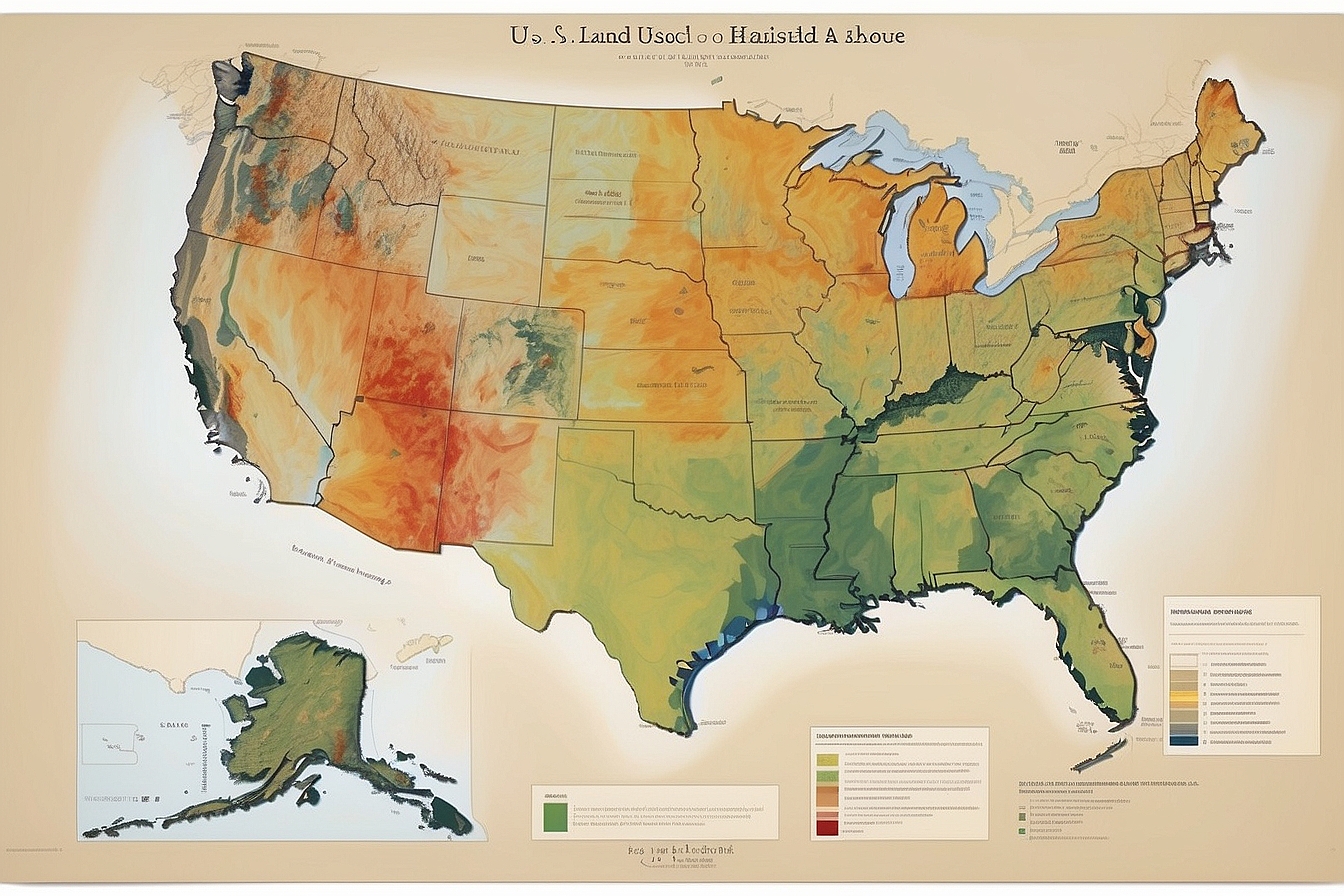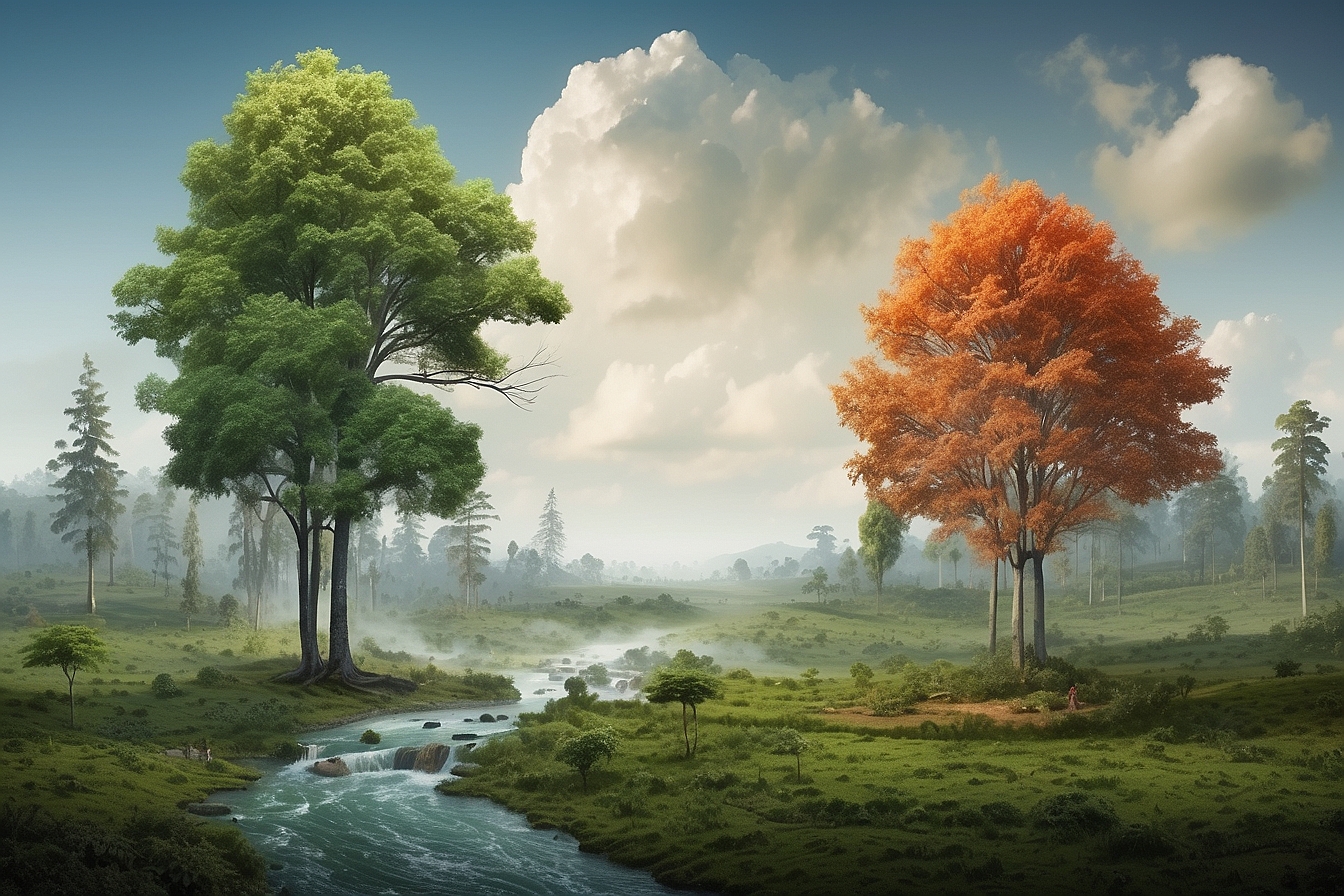The planet Earth is one very large, complex, and diverse system that came together in an extremely unlikely, yet almost serendipitous event. Operating under intricate biological, physical, chemical, and environmental conditions, life on Earth is rather delicate and is reliant upon a multitude of factors. The most comprehensive way of digesting Earth’s unique systems is through its biomes. There are five major types of biomes: deserts, forests, grasslands, tundras, and aquatic environments, all of which are dependent primarily upon the climate and geography of a particular region. These two factors then determine the type of flora and fauna that have over the years adapted to very specific environmental conditions. Here, we will explore nine continental biomes of the world in hopes of gaining a better understanding of how Mother Earth functions.
Tundra
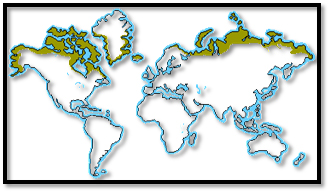 1
1
The Arctic Tundra, youngest of all biomes having been created approximately 10,000 years ago, sits between 55 and 70 degrees North.2 Its treeless environment spans approximately 20 percent of the Earth’s land surface, successfully circling around the North Pole. Due to its geographic location in the Northern latitudes, the tundra is cold and barren with an annual average temperature of -18 degrees Fahrenheit. In fact, it is so cold that the ground remains permanently frozen making it inhospitable to trees, as it is unable to support a healthy root system. Instead, the short but notable growing season of 50 to 60 days adorns the sterile landscape with ground-hugging plants such as mosses, heaths, and lichen.3
The Arctic Tundra experiences two distinct seasons: winter and summer. The winter provides the tundra with its annual burst of precipitation—mostly snowfall—ranging between 6 and 10 inches. It is also extremely windy with wind speeds of 30 to 60 miles per hours. During the summer, 24 hours of sunlight renders previously frozen tracts of land soggy and marsh-like. Lakes, bogs, and streams carve through much of the Tundra, attracting hoards of insects and subsequently, migrating birds. As the permafrost, or frozen layer of Earth, begins to melt, there is life in the tundra. There are approximately 1,700 species of plants, 400 of which are different varieties of flowers. Additionally, many mammals have adapted to the harsh environment of the tundra including: hares, rodents, wolves, foxes, polar bears, deer, caribou , and more. These mammals typically hibernate during the winter, breeding and rearing their young quickly during the summer.

Fun Fact: the Arctic Tundra is actually one of three absorbing more carbon dioxide than it releases.4
Taiga
 5
5
Otherwise known as the boreal forest, the taiga biome is the largest of all biomes. It is situated at 50 to 60 degrees North just below the Arctic Tundra and covers a rather large distance from North America to Eurasia.6;7 The taiga is known for its abundance of coniferous trees and has been dubbed the epithet, needleleaf forest. This predominately evergreen forest holds onto its leaves year long, only to photosynthesize as soon as the weather begins to warm. The branches are dressed with dark green needles that facilitate early photosynthesis and are especially notable for absorbing heat during their growing season, which lasts for approximately 130 days.8 Because of the below freezing annual average temperature, the trees grow close to one another in order to protect against the cold and harsh winds. Another remarkable adaptation unique to these conifers is their supple branches, allowing for snow to slide off under building pressure and protecting the branches from snapping. Lastly, the taiga forests are susceptible to wild fires and thus have adapted thick bark resistant to burning; only the upper canopy will burn.9
Similar to the Arctic Tundra, taiga forests have two seasons: winter and summer. The winters are extremely cold, receiving approximately 16 to 40 inches of snowfall per year.10 Summers, on the other hand, are warm, wet, and humid, receiving significant amounts of rainfall. They are generally short with 50 to 100 frost-free days.11 During the summer, millions of insects emerge seemingly from nowhere and are accompanied by flocks of migrating birds who come to feed and nest. Collectively, taiga forests receive up to 33 inches of precipitation (rain, snow, and dew) year round. Aside from the predominant coniferous trees stands, including pine, douglas fir, white spruce, and hemlock, taigas are home to a variety of mosses and lichens. Lastly, the taiga biome supports a diverse group of animals including: lynx, members of the weasel family, wolverines, bobcats, minks, red squirrels, voles, red deer, elk, moose, finches, sparrows, and crows.12
Alpine
 13
13
Alpine biomes are nestled in the world’s mountain ranges and are usually found at altitudes of approximately 10,000 feet or more.14 They are characterized by frequent snowfall events, high winds, and ice, as they typically lie “just below the snow line of a mountain.”15 There are two main seasons: summer, which begins in June and lasts through September at temperatures of 40 to 60 degrees Fahrenheit; and winter, which generally remains below freezing from October to May. Interestingly, the temperature can change very quickly on any given day, potentially going from warm to freezing!16 Due to the altitude and lack of carbon dioxide , most plants are small and close to the ground, growing and reproducing slowly. The 200 species of Alpine plants tend to be perennial, which means they live for several years and do not decompose. Also attributable to the high altitudes is a greater exposure to Ultraviolet (UV) wavelengths, as the atmosphere is much thinner and thus cannot filter UV rays as effectively. This, along with the cold climate, have lead to specific adaptations in Alpine animals that include: hibernation during the winter, migrations to lower, warmer areas, insulation of bodies with fat, shorter legs, tails, and ears in order to reduce heat loss, larger lungs, and more blood cells and hemoglobin due to the increase in pressure and lack of oxygen at higher altitudes.17
Deciduous Forest
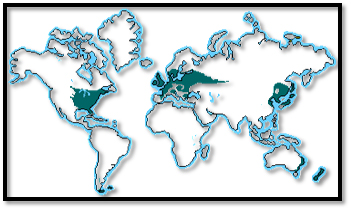 18
18
The deciduous forests of the world are scattered across the globe and can be found on the eastern half of North America, Southwest Russia, Japan, China, Southern Chile, the coast of Paraguay, New Zealand, and Southeastern Australia.19 Deciduous forests are warmer than the three previously mentioned biomes (Tundra, Taiga, and Alpine) with an annual average temperature of 50 degrees Fahrenheit. These forests receive an average rainfall of approximately 30 to 60 inches per year with about a six month growing season.20 Also known as the temperate forest, the deciduous forest has four seasons: spring, summer, autumn, and winter. Because of the warmer climate, trees can afford to lose their leaves during the winter in order to conserve water and nutrients. Many of the animals will hibernate during the winter using the trees for protection and shelter.
The forest can be divided into five zones: 1) moist conifer and evergreen broad leafed forests with wet winters and dry summers; 2) dry conifer forests at higher elevations with low precipitation events; 3) Mediterranean forests with precipitation events concentrated in the winter; 4) temperate coniferous forests with mild winters and high annual precipitation events; and 5) temperate broad-leafed rainforests with mild, frost-free winters, and evenly distributed precipitation events.21 The most common fauna seen in deciduous forests include squirrels, rabbits, skunks, birds, deer, mountain lions, bobcats, timber wolves, foxes, and black bears.22
Grasslands
 23
23
Grasslands are found at middle latitudes in the interior of continents with the exception of a few along the coast.24 As the name implies, grasslands are made up primarily of grasses, as well as flowers and herbs. Precipitation is just enough to support grasses and some trees, although the soil is too thin rendering it unable to support a thick, robust root system. Because grasses grow from the bottom up, grasslands are well adapted to wild fires and will grow back rather quickly after a wildfire event.
There are two types of grasslands: tall-grass and short-grass. Tall-grass is found in the southern hemisphere with climates that are more humid and moist, while short-grass tends to be dryer with hot summers and cold winters.25 The annual average temperature of a grassland ranges between -40 degrees Fahrenheit in the winter and 70 degrees Fahrenheit in the summer. Two main seasons are determined by a growing period and a dormant period. The growing season is characterized by 100 to 175 frost-free days, while the dormant season is generally too cold for propagation.26 The growing season of a tropical or subtropical grassland is determined by the year’s rainfall averaging between 25 and 60 inches, whereas the growing season for temperate grasslands is determined by the average temperature which falls around 50 degrees Fahrenheit. Grasslands support a unique group of fauna, such as coyotes, eagles, bobcats, gray wolves, wild turkeys, fly catchers, Canadian geese, crickets, dung beetles, bison, and prairie chickens.27
Savanna
 28
28
Savannas are tropical grasslands found between tropical rainforests and deserts. They typically straddle the equator, and are thus warm year round. Because of its geographic location, savannas get enough rain to sustain shrubs and a few isolated trees. These plants are “highly specialized” to grow in environments of long periods of drought as they are equipped with “long tap roots that can reach the deep water table, thick bark to resist annual fires, trunks that can store water, and leaves that drop off during the winter to conserve water.”29 There are two main seasons: 1) dry, perhaps counter intuitively known as winter; and 2) wet, also counter intuitively known as summer. The world’s largest and most renowned savannas are located in the middle of Africa—think the Lion King. Savannas support a large variety of grazing and browsing undulates, or hoofed animals, and the world’s most fascinating predators. For example, the Serengeti plains of Tanzania is home to lions, zebras, elephants, giraffes, leopards, cheetahs, hyenas, hawks, and buzzards. These animals are unique in that they are each adapted to eat something different, reducing competition and fostering coexistence. Lastly, African Savannas experience heavy monsoons during the summer that typically begin in May and brings with it 15 to 25 inches of rain per year.
Chaparral
 30
30
The chaparral biome is constrained to only a few, very specific regions of the Earth including: the western coast of the United States, the western tip of Australia, the West coast of South America, the Cape Town area of South Africa, and the coastal areas of the Mediterranean.31 Chaparrals can be found on different types of stereotypical “western” terrains such as mountain slopes, rocky hills, and even flat plains.32 They are adapted to a very specific climate of hot, dry summers and mild winters, also known as the Mediterranean climate for all you Californians that praise the more temperate, less extreme climate option ☺ The fauna and flora of the chaparral biome are well adapted to its climates. Plant leaves are typically small and hard with a waxy cuticle meant for retaining moisture. Common plants include: poison oak, scrub oak, shrubs, and tree cacti. Chaparral animals include: coyotes, jack rabbits, mule deer, alligator, lizards, horned toads, praying mantis, honey bee, and ladybug.33
Desert
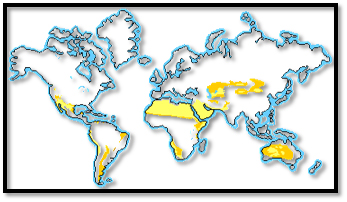 34
34
The world’s deserts cover approximately 20 percent of the Earth’s land surface with hot, dry deserts situated near the Tropics of Cancer and Capricorn, while cold deserts are near the arctic.35 Altogether, precipitation events do not exceed 20 centimeters per year.36
Deserts in hot, dry climates—where they are more commonly known to be—are generally barren with little vegetation. Most plants are low to the ground with small, thick, waxy leaves that are fully packed with nutrients such as cacti.37 In cacti, “leaves are much-reduced (to spines) and photosynthetic activity is restricted to the stems.”38 These plants have tremendous water-storing capabilities and are able to withstand the heat. Annual average temperatures range from 68 to 77 degrees Fahrenheit with little to no rainfall. Most animals will burrow underground to avoid the heat and will instead presume activities at night when it is cooler. The most common animals found in the hot and dry desert biome include nocturnal carnivores, insects, arachnids, reptiles, and birds.39
Cold deserts receive most of their precipitation during the winter and spring in the forms of rain and snow. The winters are extremely cold with rainfall being heaviest in April or May and summers never get warm enough for plants to grow, with the exception of a few lichens, grasses, and mosses.40;41 Opposite to the burrowing habits of hot and dry desert animals, cold desert animals will burrow underground to stay warm.
Tropical Rainforest
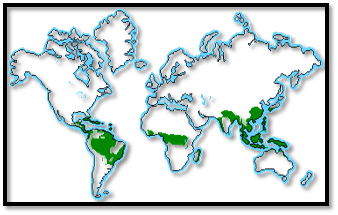 42
42
The tropical rainforests stand alone in beauty and awe. Comprising less than 6% of the Earth’s land surface, tropical rainforests are home to half of the world’s plant and animal species.43 These diverse ecosystems are found near the equator and are thus blessed with year-round warmth; average temperatures range from 68 to 93 degrees Fahrenheit. Furthermore, as per their name, rainforests receive approximately 50 to 260 inches of rainfall each year, with half of that precipitation given off through the pores of forest trees, a process known as transpiration.
The world’s rainforests can be broken down into four vertical stratifications: 1) emergent; 2) upper canopy; 3) understory; and 4) forest floor. At the emergent layer, trees of the same species grow quite far apart from one another, as they support huge “umbrella-shaped canopies” and are also protected against disease, insect infestations, and subsequent mass die-offs. These trees are between 100 and 240 feet tall and have smooth trunks, few branches, shallow root systems, and buttresses, or giant roots that cover distances of up to 30 feet. Because the emergent canopy is exposed to drying winds, leaves are small and pointed endure harsh environmental conditions. The upper canopy consists of trees 60 to 130 feet tall and supports the majority of rainforest animals due to the abundance of food at this level. The canopy is relatively dense, with vines making up 40% of canopy leaves, thusly reducing light penetration below.44
Mother Nature has strategically engineered leaves with unique drip spouts in order to keep them dry and prevent the formation of mold and mildew. The leaves are typically “dark green, small, and leathery to reduce water loss in the strong sunlight.”45 The understory is home 60 foot high trees, shrubs, and then smaller trunks of emergent and upper canopy trees. The leaves of these plants must be able to absorb as much light as possible and thus are typically very large. Because of the thick protection by the emergent and upper canopies against the outside environment, there is limited air circulation in the understory, creating a very humid, shady environment. Lastly, the forest floor is completely shaded and can only support the growth of a few bushes and herbs. The greatest activity seen on the forest floor is the decomposition of forest litter by microscopic organisms, releasing nutrients back to the forest floor.
The huge deforestation and save the rainforests!



